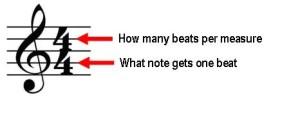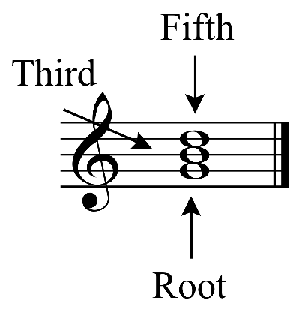REVIEW
Before we start, let’s review some basic concepts from last year’s course…
ELEMENTS OF A SCORE

Clave de sol: treble clef.
Pentagrama: staff.
Indicación de compás: time signature.
Armadura: key signature.
Compás: bar or measure.
Negra: quarter note.
Silencio de negra: quarter rest.
Blanca: half note.
Silencio de blanca: half rest.
Corchea: eighth note.
Silencio de corchea: eighth rest.
Ligature: ligadura.
Dot: puntillo.
Blanca con puntillo: dotted half note.
Barra: beam.
Dos corcheas: two eighth notes beamed together.
Casillas de repetición: repeat sign with first and second endings.
Barra de repetición: repeat sign.
Barra de repetición: repeat sign.
Rhythm
BEAT
.
Have you ever heard your heart beat? If you pay attention when you are alone you can hear a continuous ticking, each one being a beat or a pulse. When you listen to a song you can also feel the same thing, can´t you? When talking about music the beat must be constant and regular.
.
TEMPO
.
The tempo of a piece of music is its speed or, in other words, the beat speed.
.
MEASURES
.
Measure organizes the beats or pulsations in groups of two, three and four. A measure (or bar) is like a pattern of a group of beats which begin with a stressed beat. This stressed beat is the natural accent of the measure and always falls on the first beat.
It is very common to find measures having groups of two, three or four beats. We call them duple, triple and quadruple meters. The time signature appears at the beginning of a piece of music. To separate measures we use the barline. The time signature tells you two things: how many beats are in each measure, and what type of note gets a beat.
.

INTERVALS
.
An interval measures the distance between two notes. We obtain its name by counting the number of notes. The first and last note must be counted and you must know the order of the musical notes to be able to count the notes. However, not all intervals of the same numerical classification are of the same size. That is why we need to specify the quality by finding the exact number of tones and semitones in the interval.
A semitone is the smallest interval used in tonal music. A good way to think about the semitone is that it is the very next note on a piano white or black (it is also known as a half step).
A tone is two semitones (it can also be known as a whole step).
Intervals can be described, classified, or compared with each other according to various criteria:
Melodic and harmonic: Horizontal, linear, or melodic if they sound successively. Vertical or harmonic if the two notes sound simultaneously.
Depending on their direction, the melodic intervals can be ascending, when they go from low to high, or descending, if they go from high to low. In addition, melodic intervals may be described as steps or skips. A step, or conjunct motion, is a linear interval between two consecutive notes of a scale. Any larger interval is called a skip also called a leap, or disjunct motion.
CHORDS
.
In Western music, harmony is the use of different pitches simultaneously and often refers to the «vertical» aspects of music, distinguished from ideas of melodic line, or the «horizontal» aspect. Three or more notes simultaneously sounded form a chord. In our culture, the most frequently encountered chords are triads, so called because they consist of three distinct notes: the root note, and intervals of a third and a fifth above the root note. These same notes can be repeated at different pitches to enrich the chord but, basically, it will remain the same.
Chord classification
Depending on the intervals that form the triad, the chords will be classified as major, minor, diminished and augmented. Listen to their different sonorities because that is what is really important:
.
.
.
Depending on what they want to express, composers use some chords or others. In fact, the same melody can be harmonized in many ways.
.
You can build major and minor chords on any note in this Google Chrome Music Lab application
Disposition of the chords
When we arrange the chord so the bass note, the lowest note, does not coincide with the root note, we say that the chord is inverted. Thus, we speak of three dispositions: the root position, the first inversion and the second inversion.
Each one of these inversions can be represented with some numerical figures. These numbers correspond to the intervals formed by the notes added to the bass note. Therefore, 6 represents the first inversion and 64 the second. If we add a third plus to a triad we would form a seventh chord. A broken chord (an arpeggio) is a chord broken into a sequence of notes in which the notes that compose a chord are played or sung in a rising or descending order.
.
.
.















